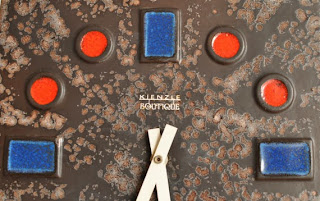Ever since I heard
that some of the West-Germany pottery factories were involved in making clocks,
I've been hoping to find one. During my 8+ years of collecting I had never been
so lucky, although I saw on the internet forums that there were plenty of fellow
collectors who managed to find lovely examples.
That was until a few
weekends ago when I biked to one of the neighboring villages to visit a fair. There were a lot of clothes and some antiques on sale, but I couldn't see
anything remotely resembling a piece of West-German ceramics. I was already
starting to wonder why I biked the whole way down here (it was quite a windy
day). And then I saw it! Tucked away behind some spice jars and oven dishes stood this
beautiful slate gray seventies clock! Could it be that I was super lucky and
this was not just a seventies clock, but a GERMAN seventies clock as well?
 |
| Kienzle Boutique clock, body made by Carstens Tönnieshof |
The first thing I
noticed after the vendor passed it to me was the name Kienzle Boutique,
confirming that it must indeed be a German clock! Kienzle is one of the oldest
clock and watch making factories in Germany, they started manufacturing in
1822, and are still in existence today. The Boutique line was launched in the
seventies, and targeted young, hip buyers that loved design. This line included metal, plastic, and ceramic items. Most items in this
boutique line were colorful, and typically seventies in design and décor.
So far, so good. But when looking for
vintage items, there is always the question of condition. You sometimes
encounter the most amazing pieces, and it is such a turn-off when you spot that
large chip or crack three seconds later, after the initial shock of finding the
item cooled down a bit. (I'm ashamed to admit that there have been occasions
when I was SO happy about I find that I became blind for damages to items, and
didn't notice them until unpacking the item at home.) But in this case the face
of the clock is in perfect vintage condition! Obviously I couldn't leave it, so
I purchased the item and happily took it home. For now it is happily ticking
away the time in my kitchen.
There still was a
bit of research left to do (my favorite part), as I would love to know who
actually made the clock. I had read that both Herbolzheim Keramik - a company
that also made kitchen ware and wall plates - and Carstens Tönnieshof made ceramic bodies for Kienzle. Based on
that info and comparable examples I figured this one was probably made by
Carstens, but I wasn't sure. Luckily the lovely folks on the pottery and glassforum were able to confirm for me that this item is indeed made by Carstens
Tönnieshof voor Kienzle.
So there you have
it! My first West-Germany pottery wall clock. I love the Mid Century Modern
look of this clock, with its simple square shape, nice clean lines and well
placed red and blue color accents. The thick metal hanging chain gives it that
characteristic seventies feel. Carstens and Kienzle have produced a great piece
of art in this collaboration!







